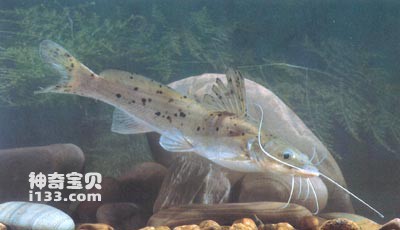Mystus guttatus belongs to the order Caturiformes, the family Mystus, and the genus Mystus. Commonly known as: catfish, sesame catfish, plum blossom, catfish. English name: Spotted longbarbel catfish.
The body is long and the sides are flat. The head is flat and the snout is broad and rounded, slightly like a plowshare. The mouth is wide, depressed, and curved. The upper and lower jaw denticles are arc-shaped, the palatine denticles are slightly semicircular, and the teeth are villi-shaped. The lips are thick and the lower lip is discontinuous in the middle. The two nostrils are slightly close together, the anterior nostril is tubular, and there are nasal whiskers on the front edge of the posterior nostril. There are 4 pairs of barbels: the maxillary barbel is the largest, and its end reaches the base of the pelvic fin; the nasal barbel is shorter; there are 2 pairs of barbels, and the outer pair is longer and reaches the gill opening. The eyes are equal in size and the eyelids are free. The dorsal fin is short, with short and thin spines, and the trailing edge has thin and weak serrations; the pectoral fin spines are flat and long, with thin and thin serrations on the front edge, buried under the skin, and the rear edge has thick serrations; the pelvic and anal fins are short and have no spines. The adipose fin is high and extremely long, with its starting point close to the dorsal fin and its end close to the caudal fin, but not connected to the caudal fin. The trailing edge is free and rounded; the caudal fin is bifurcated and the upper lobe is slightly longer. The body is brown and the abdomen is yellow; there are irregularly arranged round blue spots of varying sizes on the sides of the body (young fish have no spots). The dorsal fin, adipose fin and caudal fin are gray-black with small brown spots; the pectoral fin, pelvic fin and anal fin are light in color with few spots.
It inhabits the bottom of rivers and feeds on small aquatic animals, such as aquatic insects, small fish, shrimps, etc., and also eats a small amount of detritus of higher aquatic plants. It breeds from April to June every year, but mature individuals are also found from June to August.
Distributed in the Qiantang River, Jiulong River, Hanjiang River, Pearl River, Yuanjiang River and other water systems.
The individuals are large, with common individuals weighing 1-2 kg, and larger individuals weighing 5-10 kg, with the largest reaching 15 kg. The meat is tender, delicious and abundant in quantity. It is an important economic fish in the production area. Especially in Xijiang, it is regarded as one of the rare fish in Xijiang.

animal tags:
We created this article in conjunction with AI technology, then made sure it was fact-checked and edited by a Animals Top editor.